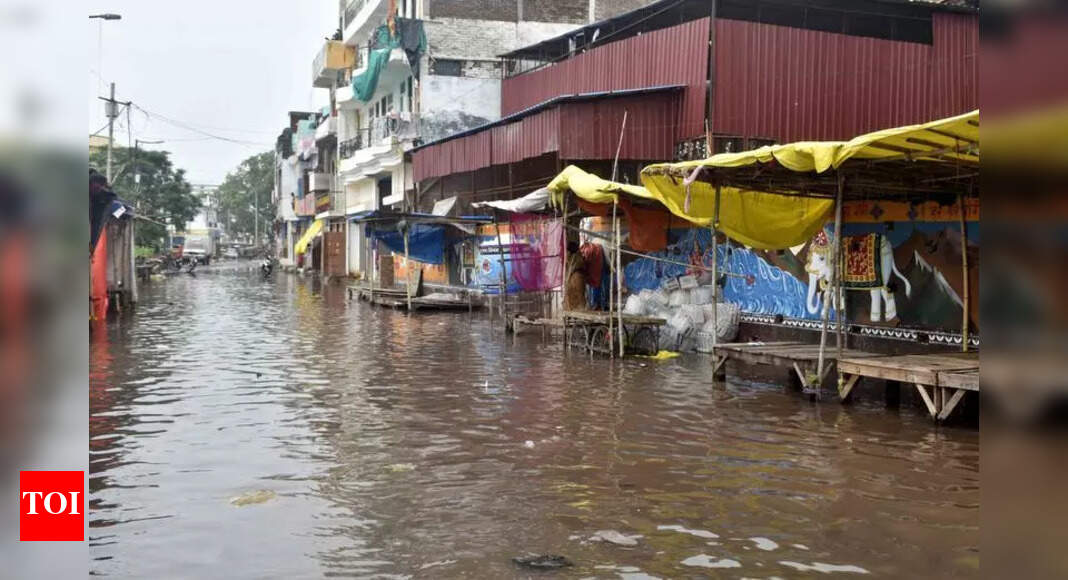Health
Flooding Affects Over 150,000 Families as Ganga and Yamuna Rise

The water levels of the Ganga and Yamuna rivers in Prayagraj have surged sharply, affecting more than 150,000 families as floodwaters inundate both rural and urban areas. By Sunday morning, floodwaters reached 16 villages and seven city neighbourhoods, prompting local authorities to remain on high alert while they continue their flood management efforts.
As of Sunday at 08:00, the Yamuna River at Naini rose significantly, increasing by 56 cm to reach 83.19 meters, just 1.5 meters below the danger mark of 84.734 meters. The Ganga at Phaphamau measured 83.06 meters, having risen by 45 cm. Other locations, including Chhatnag and Buxi STP, recorded levels of 82.41 meters and 82.90 meters, respectively.
By 16:00 on Sunday, there was a slight decline in water levels, with the Yamuna at Naini dipping to 82.86 meters. The Ganga’s levels showed mixed changes; Phaphamau increased marginally to 83.09 meters, while Chhatnag and Buxi STP experienced decreases of 4 cm and 9 cm, respectively. Despite these slight improvements, local officials remain vigilant as the threat of flooding persists, particularly in low-lying areas such as Baghdara, Salori, Beli, Rajapur, and Ashok Nagar.
Residents in these regions are taking precautions. Abhishek Yadav, a resident of Baghdara, expressed his concerns, stating he has gathered essential items in anticipation of his home being submerged. Local officials are conducting assessments in the hardest-hit areas. Sub-Divisional Magistrate Abhishek Kumar Singh visited Daraganj, Salori, and Rajapur on Saturday, advising residents to evacuate early.
Relief operations have commenced, with two camps established in Sadar Tehsil—Annie Besant Relief Camp and Cantt Marriage Hall—offering shelter to 50 individuals as of Saturday evening. These numbers are expected to grow as more areas become submerged. The District Magistrate, Ravindra Kumar Mandar, reassured the public that relief efforts are ongoing, with teams from the National Disaster Response Force (NDRF), State Disaster Response Force (SDRF), and civil defence actively rescuing residents using boats.
In the Badra Sonoti region, 11 boats are currently operational, ferrying residents as road access becomes increasingly compromised. Although water levels have stabilized, experts caution that the situation remains precarious. Additional rainfall upstream could potentially lead to renewed flooding.
The irrigation department is actively managing water levels, reporting controlled releases of 46,000 cusecs from Bhuraghat Barrage and 80,000 cusecs from Ken Barrage, which are anticipated to reach Prayagraj by Sunday night. Executive Engineer Digvijay Narayan Shukla noted that while the release rates have declined, both rivers are still under substantial pressure.
As conditions remain uncertain, officials are on high alert, closely monitoring the situation and urging the public to prepare for possible evacuations should circumstances worsen. The community’s resilience is being tested, and local leaders continue to emphasize the importance of safety and preparedness in the face of natural disasters.
-

 World5 months ago
World5 months agoSBI Announces QIP Floor Price at ₹811.05 Per Share
-

 Lifestyle5 months ago
Lifestyle5 months agoCept Unveils ₹3.1 Crore Urban Mobility Plan for Sustainable Growth
-

 Science4 months ago
Science4 months agoNew Blood Group Discovered in South Indian Woman at Rotary Centre
-

 World5 months ago
World5 months agoTorrential Rains Cause Flash Flooding in New York and New Jersey
-

 Top Stories5 months ago
Top Stories5 months agoKonkani Cultural Organisation to Host Pearl Jubilee in Abu Dhabi
-

 Sports4 months ago
Sports4 months agoBroad Advocates for Bowling Change Ahead of Final Test Against India
-

 Science5 months ago
Science5 months agoNothing Headphone 1 Review: A Bold Contender in Audio Design
-

 Top Stories5 months ago
Top Stories5 months agoAir India Crash Investigation Highlights Boeing Fuel Switch Concerns
-

 Business5 months ago
Business5 months agoIndian Stock Market Rebounds: Sensex and Nifty Rise After Four-Day Decline
-

 Sports4 months ago
Sports4 months agoCristian Totti Retires at 19: Pressure of Fame Takes Toll
-

 Politics5 months ago
Politics5 months agoAbandoned Doberman Finds New Home After Journey to Prague
-

 Top Stories5 months ago
Top Stories5 months agoPatna Bank Manager Abhishek Varun Found Dead in Well









